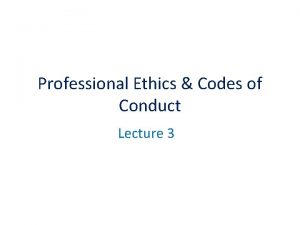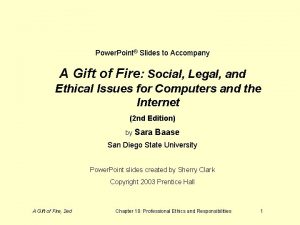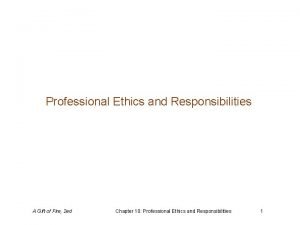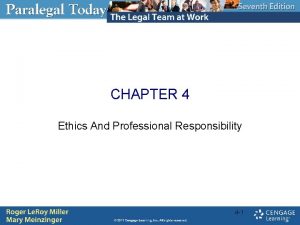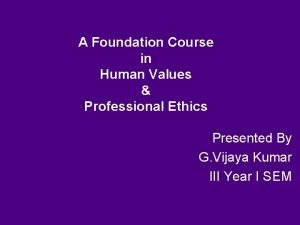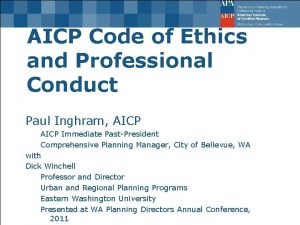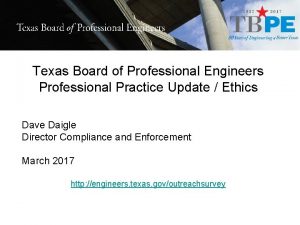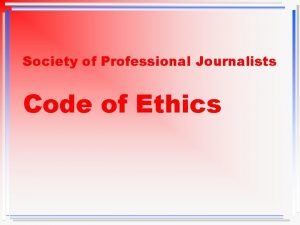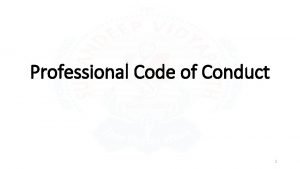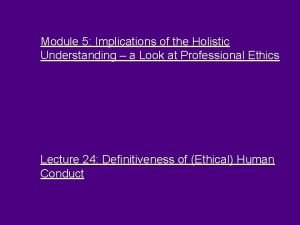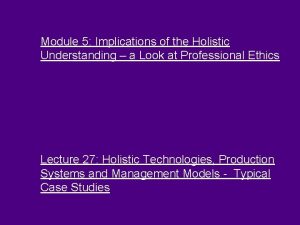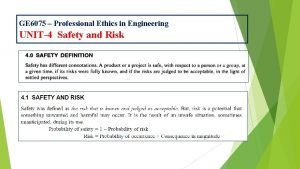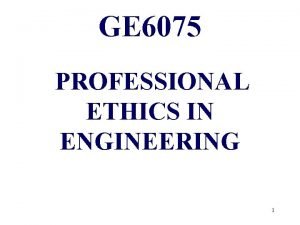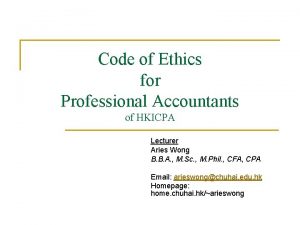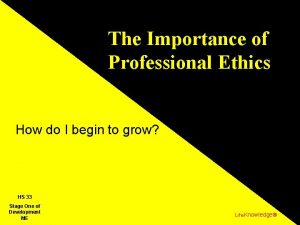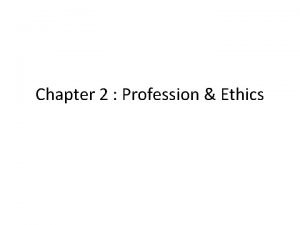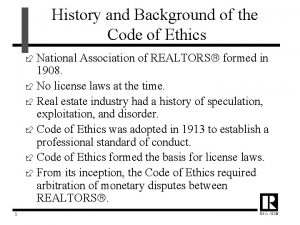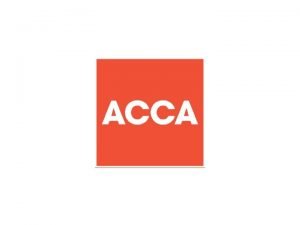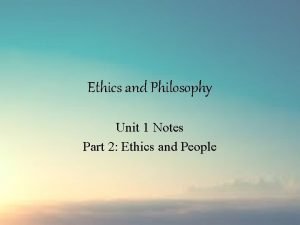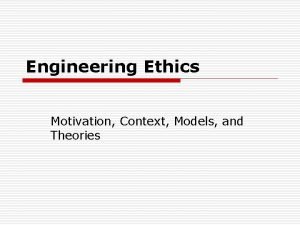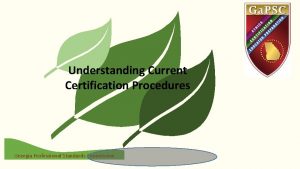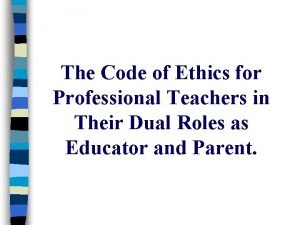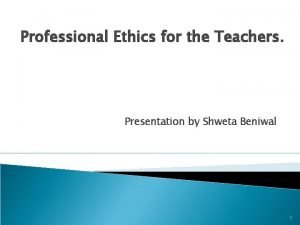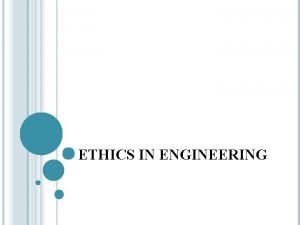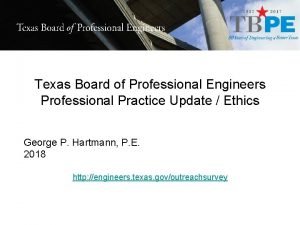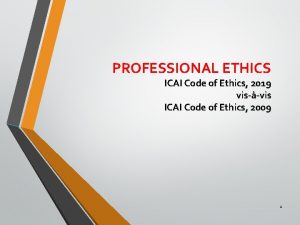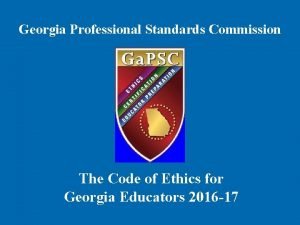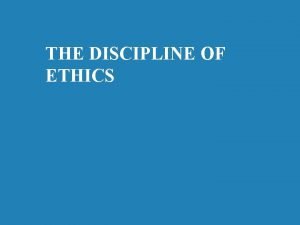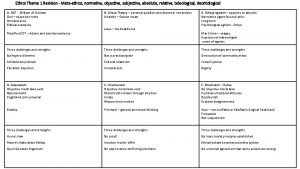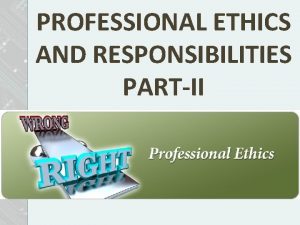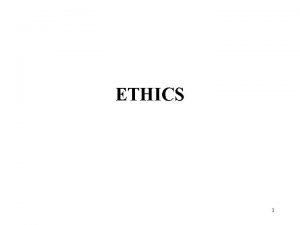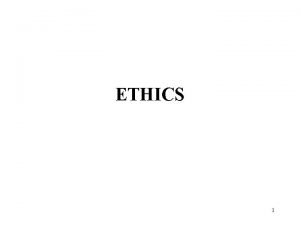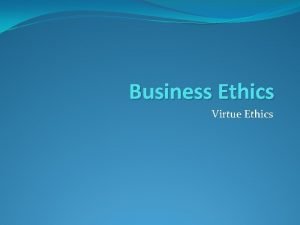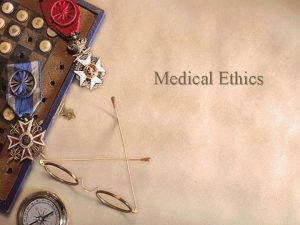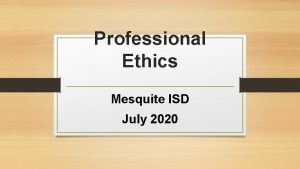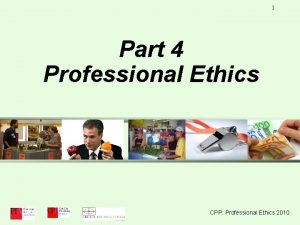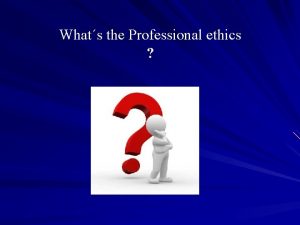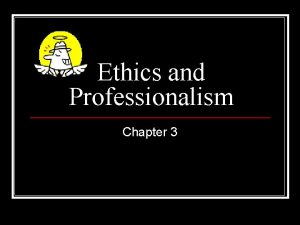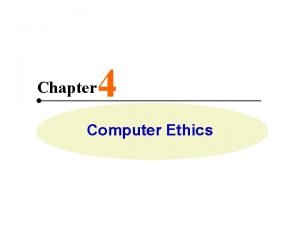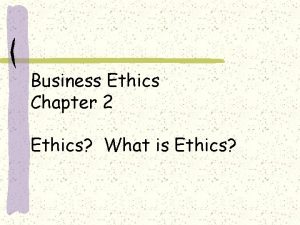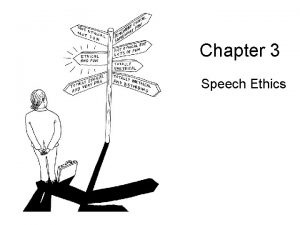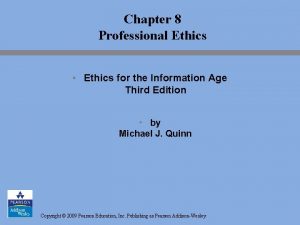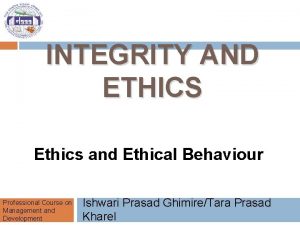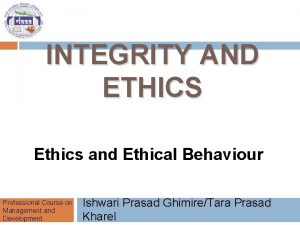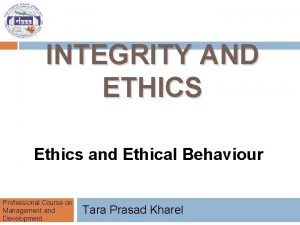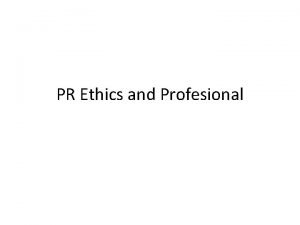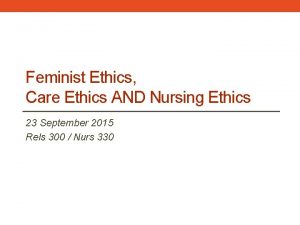Chapter 3 Professional Ethics 1 Professional Ethics and








































- Slides: 40

Chapter 3 Professional Ethics - 1

Professional Ethics and Public Accountants • Ethics can be broadly defined as a set of moral principles or values. • Professional ethics are the morally permissible standards of conduct that apply to the members of a particular profession. Professional Ethics - 2

• For public accountants, the overriding responsibility is the protection of the public interest. • The five fundamental principles that guide the ethical behaviours of public accountants (PAs) are: • According to the CPA Code of Professional Conduct, these ethical principles are aimed first and foremost Professional Ethics - 3

A Framework for Ethical Reasoning • The structure of the auditor–client relationship has an inherent conflict of interest • Given the auditor’s unique role and its public interest obligations, it is essential that Professional Ethics - 4

A Framework for Ethical Decision Making • A generic framework for the resolution of ethical dilemmas. 1. Obtain the relevant facts and identify issues; 2. Identify the ethical issues; Professional Ethics - 5

3. Identify who is affected and how each is affected; 4. Consider and evaluate courses of action; see the next slide 5. Implement the course of action. Professional Ethics - 6

Consider and Evaluate Courses of Action • Below is a list of tests that a CPA could use to consider the appropriateness of the course of action: – – Harm test Rights test Publicity test Defensibility test – Virtue test – Professional test – Colleague test – Firm test Professional Ethics - 7

Ethical Blind Spots • Decision makers are susceptible to judgment traps or what is referred to as ethical blind spots. • These are unconscious judgmental tendencies • An example is failing to see an ethical issue Professional Ethics - 8

Problem 4 -25, 13 th edition Barbara Whitley had great expectations about her future as she sat at her graduation ceremony in May 2015. She was about to receive her Master of Accountancy degree, and the following week she would begin her career on the audit staff of Green, Thresher & Co. , a public accounting firm. Things looked a little different to Barbara in February 2016. She was working on the audit of Delaney Fabrics Ltd. , a textile manufacturer with a calendar year-end. The pressure was enormous. Everyone on the audit team was putting in 70 -hour weeks, and it still looked as if the audit would not be done on time. Barbara was doing work in the property area, vouching additions for the year. The audit program indicated that a sample of all items over $10, 000 should be selected, plus a non-statistical sample of smaller items. When Barbara went to take the sample, Jack Bean, the senior, had left the client’s office and could not answer her questions about the appropriate size of the judgmental sample. Barbara forged ahead and selected 50 smaller items on her own judgment. Her basis for doing this was that there were about 250 such items, so 50 was a reasonably good proportion of such additions. Barbara audited the additions with the following results: The items over $10, 000 contained no errors; however, the 50 small items contained a large number of errors. In fact, when Barbara projected them to all such additions, the amount seemed quite significant. A couple of days later, Jack Bean returned to the client’s office. Barbara brought her work to Jack in order to inform him of the problems she found, and got the following response: “Barbara, why did you do this? You were supposed to look only at the items over $10, 000, plus 5 or 10 little ones. You’ve wasted a whole day on that work, and we can’t afford to spend more time on it. I want you to throw away the schedules where you tested the last 40 small items and forget you ever did them. ” When Barbara asked about the possible audit adjustment regarding the small items, none of which arose from the first 10 items, Jack responded, “Don’t worry, it’s not material anyway. You just forget it; it’s my concern, not yours. ” REQUIRED a) In what way is this an ethical dilemma for Barbara? b) Using the ethical decision-making framework, analyse Barbara’s ethical dilemma. c) What should Barbara do to resolve the dilemma? Professional Ethics - 9

Solution to 4 -25 a) It’s an ethical dilemma for Barbara because she has a decision to make about what behavior is appropriate. If she throws the schedules away, as suggested by her supervisor, she may not be carrying out her professional responsibility to the public or the client. If she does not throw the schedules away, she will likely cause a confrontation between herself and her supervisor. b) x 1. Relevant facts: A number of misstatements were discovered. The aggregate amount of all discovered and undiscovered misstatements may be material. The audit supervisor wants Barbara to throw away some of her work. 2. Ethical issues: Is it ethical to throw away the schedules containing some small misstatements when her supervisor instructs her to do so? 3. Who is affected and how? WHO IS AFFECTED? Barbara Jack Green, Thresher & Co. , CPAs Delancey Fabrics HOW? 1. 2. 3. 1. 2. Being asked to ignore misstatements is a possible violation of Rule 102. Performance evaluation may be affected. Future with firm may be affected. Performance evaluation may be affected. 1. 2. 3. If audit is completed late, they may lose the engagement. May be sued if material misstatements are not detected. Client may be unhappy with auditor if misstatements are subsequently discovered. May not have opportunity to correct misstatements if they are not brought to light. May be required to adjust financial statements if misstatements exist. 1. 2. Professional Ethics - 10

c) Alternatives 1) Throw away schedules. 2) Inform Jack that she will not throw schedules away. 3) Talk to manager or partner about Jack’s request. 4) Refuse to work on the engagement. 5) Quit the firm. d) Consequences 1) The misstatements may be discovered subsequently and the firm may lose the client, or be sued. Even if the misstatements are not material, the client may be justifiably upset because the problems giving rise to the misstatements may have been solved sooner. 2) Barbara informs Jack that she won’t throw away schedules. This may result in a confrontation. She may get an unfavorable review. 3) If she talks to the manager or partner, they may admire Barbara’s attempt to be ethical, or they may think she is out of line for bypassing Jack’s authority without discussing the matter with him in detail. 4) If she refuses to continue on the engagement, it will not look good on Barbara’s record. She may be labeled as “hard to get along with. ” 5) If she quits, she will likely miss out on some potentially valuable experiences in public accounting. e) Appropriate Action Only Barbara can decide. One reasonable approach is for Barbara to start by discussing the matter further with Jack. She should listen carefully to his reasoning and express her reservations about throwing the schedules away. She should not subordinate her judgment to Jack. If Jack satisfies her that it is acceptable to throw the schedules away (this seems unlikely in the circumstances), then she may be justified in doing so. However, if she still has reservations, she should inform Jack that she intends to contact a manager or partner. Professional Ethics - 11

Professional Guidance on Ethical Conduct • The provincial accounting associations determine the rules of professional conduct for members and students • The professional code of conduct in Canada is both principlesbased and compliance-based. Professional Ethics - 12

CPA Ontario Code of Professional Conduct: Section 200 (Public Protection • Rule 201—Maintenance of good reputation of the profession • Rule 202—Integrity, due care, and objectivity • Rule 203—Professional competence • Rule 204—Independence • Rule 205—False and misleading documents and oral representations • Rule 206—Compliance with professional standards Professional Ethics - 13

• Rule 208—Confidentiality of information • Rule 210—Conflicts of interest • Rule 211—Duty to report breaches of the CPA Code • Rule 214—Fee quotations and billings • Rule 215—Contingent fees • Rule 217—Advertising, solicitation, and endorsements • Rule 218—Retention of documentation and working papers Professional Ethics - 14

Rule 201: Professional Behaviour • Members should behave in the best interests of • A member should not be publicly critical of a colleague Professional Ethics - 15

Rule 202: Integrity, Due Care, and Objectivity • The rules of conduct for professional accountants require members • Due care means the application by a professional of a level of care and skill Professional Ethics - 16

Rule 203: Competence • The rules of conduct require practitioners to maintain competence. • Professional accountants are required • An auditor should not undertake an audit of a client unless Professional Ethics - 17

Rule 204: Independence • Independence in fact • Independence in appearance Professional Ethics - 18

Rule 205: Association with False and Misleading Information • No members, whether in public accounting or industry, Professional Ethics - 19

Rule 206: Adherence to Professional Standards • PAs are required to comply with professional standards when preparing and auditing financial statements Professional Ethics - 20

Rule 208: Confidentiality • The rules of conduct for PAs state that members shall not disclose any confidential client information or employer information • The rules also prohibit using • Ordinarily, the public accounting firm’s working papers Professional Ethics - 21

Rule 215: Contingent fees • Contingent fees are prohibited for audits. Professional Ethics - 22

CPA Ontario Code of Professional Conduct: Section 300 (Professional Colleagues) • Rule 302—Communication with predecessor • Rule 303—Provision of client information Professional Ethics - 23

Independence • Independence is probably the most critical of all principles when an auditor is engaged to perform an audit. • The auditor must have both • The auditor must be independent when conducting Professional Ethics - 24

Threats to Independence • The auditor is required to consider five facets of independence before accepting or continuing an engagement. – Self-interest – Advocacy – Intimidation – Self-review – Familiarity • These threats must be documented and the threat eliminated or reduced to what is called an acceptably low level. • If the threats cannot be eliminated or reduced to an acceptably low level • Each identified independence threat must be Professional Ethics - 25

Self-Interest Threat • When the member has a financial interest in the client or in the financial results of the client. Professional Ethics - 26

Advocacy Threat • When the firm or member is perceived to promote (or actually does promote) the client’s position. Professional Ethics - 27

Intimidation Threat • When the client intimidates the firm or staff with respect to the content of the financial statements or with respect to the conduct of the audit. Professional Ethics - 28

Self-Review Threat • When a PA has made judgments in previous engagements that need to be re-evaluated Professional Ethics - 29

Familiarity Threat • When it is difficult to behave with professional skepticism during the engagement. Professional Ethics - 30

Safeguards to Independence Table 3 -3 Safeguards to Independence Safeguard Category Examples Created by the profession, legislation, or securities regulation Education and training provided by the professional accounting body Practice review conducted by the professional accounting body or by the CPAB (Canadian Public Accountability Board) Periodic rotation of senior members on the engagement Provided by the client A qualified, independent audit committee Corporate governance policies that restrict certain services with the external auditor Corporate polices or ethical codes that stress ethical behaviour and provide channels to discuss ethical issues Available within the firm’s systems and procedures Tone at the top encouraging high-quality auditing and professional skepticism Firm policies and procedures that promote awareness and ensure compliance for independence Rotation of senior personnel on client engagements Required consultation Professional Ethics - 31

Safeguards at the Client: Importance of an Audit Committee • An audit committee is a selected number of members of a company’s board of directors • Securities laws require that the auditor of listed entity report to Professional Ethics - 32

Professional Conduct • With the Rules of Professional Conduct, there a number of key matters addressed: – – – • 201 - Professional Behaviour; 202 - Integrity and Due Care; 203 - Competence; 205 - Association with False and Misleading Information 206 - Adherence to Professional Standards; 207 - Confidentiality; Rules 204. 1 to 204. 10 Professional Ethics - 33

Rule 204 - Sections 1. Definition of independence in assurance and specified auditing procedures engagements 2. Identification of threats and safeguards 3. Documentation required for a decision to accept or continue an engagement after a threat to independence is identified 4. Specific prohibitions that members and firms shall comply with across a range of situations where independence is threatened 5. Required procedures for members to disclose prohibited interests and relationships 6. Obligations and procedures for firms, partners and professional employees to ensure compliance 7. Maintenance of independence in insolvency engagements 8. Disclosure of impaired independence 9. Requirements and processes when a member or firm has breached an independence requirement 10. Audits under elections legislation Professional Ethics - 34

Specific Prohibition (204. 4) • Prohibitions serve as an effective means to prevent independence threats. In some cases, • The text has a detailed list of prohibitions applicable to all assurance engagements (Page 65) • 204. 4. The Rule provides that a firm may not permit any member of the firm to have a relationship with or an interest in an assurance client, or provide a service to an assurance client, which is precluded by Rule 204. Professional Ethics - 35

Rule 204. 4 – specific prohibitions • Members of the engagement team: • Loans: • Close business relationship: • Significant influence: • Director or officer: • Management functions: • Journal entries and accounting classifications: • Gifts or hospitality: Professional Ethics - 36

Rule 204. 4 – specific prohibitions, continued • Non-assurance services: • Fees: • Services not to be provided – – – – Accounting and bookkeeping Valuation services involving high degree of subjectivity and having a material affect on the financial statements Internal audit Financial information systems design and implementation Litigation support Legal Corporate finance Tax planning Professional Ethics - 37

Enforcement of the Code of Professional Conduct • The rules of conduct for CPAs are established and administered provincially. • The various professional bodies have the power to impose penalties ranging • The professional accounting bodies are self-regulating. Professional Ethics - 38

Problem 3 -23 – 14 th Edition a) John Brown is a PA, but not a partner, with three years of professional experience with Lyle and Lyle, Public Accountants, a oneoffice public accounting firm. He owns 25 shares of stock in an audit client of the firm but does not take part in the audit of the client and the amount of stick is not material in relation to his total wealth. b) In preparing the corporate tax returns for a client, Phyllis Allen, PA, observed that the deductions for contributions and interest were unusually large. When she asked the client for backup information to support the deductions, she was told, “Ask me no questions, and I will tell you no lies. ” Phyllis completed the return on the basis of the information acquired from the client. c) A private entity audit client requested assistance of Kim Tanabe, PA, in the installation of a computer system for maintaining production records. Kim had no experience in this type of work and no knowledge of the client’s production records, so she obtained assistance from a computer consultant. The consultant is not in the practice of public accounting, but Kim is confident in her professional skills. Because of the highly technical nature of the work, Kim is not able to review the consultants work. d) Five small Moncton accounting firms have become involved with an information project by taking part in an inter firm working paper review program. Under the program, each firm designates two partners to review the working papers, including the tax returns and the financial statements, of another public accounting firm taking part in the program. At the end of each review, the auditors who prepared the working papers and the reviewers have a conference to discuss the strength and weaknesses of the audit. They do not obtain the authorization from the audit client before the review takes place. e) Roberta Hernandez, PA, serves as controller of a Canadian company that has a significant proportion of its operations in several South American countries. Certain government provisions in selected countries require the company to file financial statements based on international standards. Roberta oversees the issuance of the company’s financial statements and asserts that the statements are based on international financial accounting standards; however, the standards she uses are not those issued by the International Accounting Standards Board. Professional Ethics - 39

f) Bill Wendall, PA, set up a casualty and fire insurance agency to complement his auditing and tax services. He does not use his own name on anything pertaining to the insurance agency and has a highly competent manager, Renate Jones, who runs it. Bill frequently requests Renata to review with the management of an audit client the adequacy of the client’s insurance if it seems underinsured. He feels that he provides a valuable service to clients by informing them when they are underinsured. g) Michelle Rankin, PA, provides tax services, management advisory services, and bookkeeping services and conducts audits for the same private company client. She requires management to approve, in writing, transactions and journal entries. Since her firm is small, the same person frequently provides all services. REQUIRED Indicate whether each is a violation and explain why you think it is or is not. Professional Ethics - 40
 8 general moral imperatives
8 general moral imperatives Ethics and professional responsibility cpd
Ethics and professional responsibility cpd State legal ethical and professional aspects of security
State legal ethical and professional aspects of security Cips code of ethics and professional conduct
Cips code of ethics and professional conduct A gift of fire
A gift of fire Nala's paralegal canons of ethics
Nala's paralegal canons of ethics Foundation course in human values and professional ethics
Foundation course in human values and professional ethics Aicp code of ethics and professional conduct
Aicp code of ethics and professional conduct Compare micro-ethics and macro-ethics.
Compare micro-ethics and macro-ethics. Texas board of professional engineers ethics exam
Texas board of professional engineers ethics exam Code of ethics society of professional journalists
Code of ethics society of professional journalists Code of conduct professional ethics
Code of conduct professional ethics Holistic understanding of harmony on professional ethics
Holistic understanding of harmony on professional ethics Holistic technology in human values
Holistic technology in human values Risk benefit analysis in professional ethics
Risk benefit analysis in professional ethics Living peacefully in professional ethics
Living peacefully in professional ethics Prc br435 – code of ethics for professional teachers
Prc br435 – code of ethics for professional teachers Code of ethics for professional accountants
Code of ethics for professional accountants Professional ethics presentation
Professional ethics presentation Challenger ethics case study
Challenger ethics case study Importance of professional ethics
Importance of professional ethics Characteristics of a profession
Characteristics of a profession 6075 meaning
6075 meaning Professional ethics in engineering notes
Professional ethics in engineering notes Code of ethics 3 major sections
Code of ethics 3 major sections Professional ethics decision-filter
Professional ethics decision-filter Professional ethics unit 1 notes
Professional ethics unit 1 notes Minimalist model of professional ethics
Minimalist model of professional ethics Tpms program completion form
Tpms program completion form Violation of code of ethics for professional teachers
Violation of code of ethics for professional teachers Why is confidentiality important
Why is confidentiality important Teachers ethics
Teachers ethics Professional ethics examples
Professional ethics examples Professional ethics in engineering
Professional ethics in engineering Tbpe online ethics exam answers
Tbpe online ethics exam answers Code of conduct icai
Code of conduct icai Georgia educator code of ethics
Georgia educator code of ethics Everyday ethics for the criminal justice professional
Everyday ethics for the criminal justice professional What is environmental ethics
What is environmental ethics Descriptive ethics vs normative ethics
Descriptive ethics vs normative ethics Metaethics vs normative ethics
Metaethics vs normative ethics
